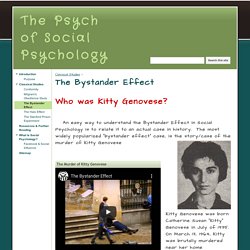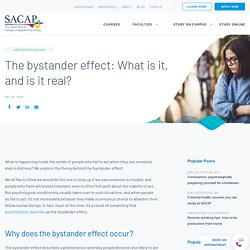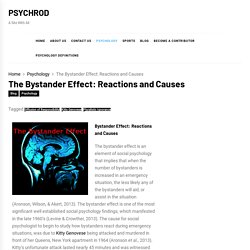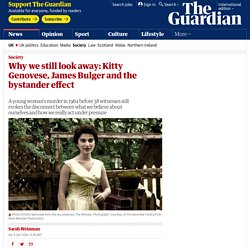

However, this could be overcome through the use of certain tactics like gaining knowledge through trainings or situational power. The Bystander Effect - The Psych of Social Psychology. Who was Kitty Genovese?

An easy way to understand the Bystander Effect in Social Psychology is to relate it to an actual case in history. The most widely popularized "bystander effect" case, is the story/case of the murder of Kitty Genovese The Murder of Kitty Genovese Kitty Genovese was born Catherine Susan "Kitty" Genovese in July of 1935. On March 13, 1964, Kitty was brutally murdered near her home (apartment) in Queens, New York. The Science of Empathy. Understanding the Bystander Effect.
If you witnessed an emergency happening right before your eyes, you would certainly take some sort of action to help the person in trouble, right?

While we might all like to believe that this is true, psychologists suggest that whether or not you intervene might depend upon the number of other witnesses present. What Is the Bystander Effect? The term bystander effect refers to the phenomenon in which the greater the number of people present, the less likely people are to help a person in distress. When an emergency situation occurs, observers are more likely to take action if there are few or no other witnesses. Being part of a large crowd makes it so no single person has to take responsibility for an action (or inaction).
Article #1 - Why does the Bystander Effect occur? What is happening inside the minds of people who fail to act when they see someone else in distress?

We explore the theory behind the ‘bystander effect’. We all like to think we would be the one to step up if we saw someone in trouble; and people who have witnessed traumatic events often feel guilt about the inability to act. But psychological conditioning usually takes over in such situations, and when people do fail to act, it’s not necessarily because they made a conscious choice to abandon their fellow human beings. Article #2 - The Bystander Effect: Reactions and Causes - PSYCHROD.
Bystander Effect: Reactions and Causes.

Article #3 - Understanding Pluralistic Ignorance in Social Psychology. Article #4 - How Diffusion of Responsibility Affects People. Diffusion of responsibility is a psychological phenomenon in which people are less likely to take action when in the presence of a large group of people.1 For example, imagine that you are in a large city on a bustling street.

You notice a man fall to the ground and start convulsing as if having a seizure. Many people turn and look at the man, but no one moves to help or call for medical assistance. Why? Because there are so many people present, no one person feels pressured to respond. Facts & Summary of Kitty Genovese. Catherine Susan “Kitty” Genovese was born in Brooklyn, New York, on July 7, 1935, to parents Vincent and Rachel Genovese.

The oldest of five children, Genovese was a graduate of Prospect Heights High School and remembered as a very good student and voted “Class Cut-Up” in her senior year. Following her graduation in 1953, Genovese’s mother witnessed a murder on the streets, which motivated the family to move to New Canaan, Connecticut. Kitty Genovese, however, remained in New York City, working as a secretary at an insurance company and working nights at Ev’s 11th Hour, a bar in the Hollis neighborhood of Queens, first as a bartender then as the manager, prompting her to move to Queens. A decade later, Genovese met her lesbian girlfriend, Mary Ann Zielonko, in a Greenwich Village nightclub. The two found a second-floor apartment together in Kew Gardens in Queens, considered a peaceful, safe area to live.
Why we still look away: Kitty Genovese, James Bulger and the bystander effect. More than half a century later, the death of Kitty Genovese continues to remind us of the disconnect between what we believe about ourselves and how we really act under pressure.

The murder of the 28-year-old outside her apartment in the Queens neighborhood of Kew Gardens in the early morning of 13 March 1964 rippled through New York City and around the world. How could a young, independent woman who lived on her own terms be so easily struck down? How could so many neighbors look on and turn away as she was stabbed repeatedly on the street and in her apartment building? What did that collective inability to act reveal about ourselves, our communities, and our belief systems? Genovese’s killer, Winston Moseley, died in prison this week, bringing the case and its implications back into the spotlight. Two weeks after her murder, Rosenthal assigned a story with the damning headline: “Thirty-Seven Who Saw Murder Didn’t Call Police.”
The legend of Kitty Genovese and those who ignored her screams. When I was growing up in New York City, everyone knew about Kitty Genovese.

We all knew the story of the 28-year-old bar manager who had been robbed, raped and stabbed to death outside her apartment building in Queens in 1964 while 38 people watched or listened to her screams outside their apartments but did nothing to stop the attack. It was more than just another tabloid murder; it was a morality tale — exhibit A for the argument that cities were alienating and dehumanizing, that there was no such thing as neighborhood or community, that people were cold, cruel, selfish, indifferent. Even today, Kitty Genovese’s name is still invoked not just in New York but around the world when people fail to come to each other’s aid in times of violence and trouble. Thirty-eight witnesses, the New York Times said, and no one did anything over the 35 minutes the attack was taking place. Not one called the police while it was underway, even though Genovese was screaming, “Please help me.
Bystander effect: The Case Of Kitty Genovese. Example #1 - 10 Notorious Cases of the Bystander Effect. Example #2 - Raymond Zack (2011) 50-year-old Raymond Zack waded into the surf on an Alameda, California beach and stood calmly in the 54-degree water, apparently waiting to die.

His suicide took nearly an hour, but eventually he drowned, with no rescue attempts from any of the 75 San Franciscans who gathered on the shore to watch the entire tragedy. Why didn’t anyone try to rescue the man? Apparently it was because nobody was paid to do it. You see, stopping Zack from killing himself wasn’t anyone’s job. Excample #3 - Radil Hebrich (2014) A Quebec coroner says a man who was seriously injured by a subway train and collapsed on a Metro platform in Montreal might have had a chance to survive, if only someone had helped him.

Coroner Jacques Ramsay released a report today on the death of Radil Hebrich, 59, who was hit and killed by a Metro car in January 2014 at Langelier station in Montreal's east end. Hebrich had been drinking and stumbled across the yellow warning line at the edge of the platform and was hit in the head by the side of a passing train. He fell onto the platform and was bleeding profusely. The entire incident was caught on security cameras. "It's very provocative, because for 16 minutes you see Mr. The coroner writes that dozens of people and three Metro trains passed by as he bled from the head. No one intervened to help Hebrich. "Some people actually turn and look at what's happening, but nobody goes to give him help," said Ramsay.
"If you're 19 minutes without CPR … it does not help your chances," he said. Example #5 - Khaseen Morris (2019) On Sept. 17, the life of a 16-year-old high schooler in Long Island ended tragically in a violent brawl outside a strip mall. Khaseen Morris was told to show up outside the mall at a certain time by several others his age, after he was seen walking home the girlfriend of another boy. Morris showed up and was immediately attacked by a group of five teenagers. Bystander Apathy Experiment.
An Illustration of the Bystander Effect. Social Experiment #1. Social Experiment #2. Social Experiment #3. 4 Major Implications of Bystander Effect on the Society. Bystander effect: Training in skills makes people more willing to help, Letters in Print News. 5 steps for overcoming the crippling "bystander effect". Given the choice, Kitty Genovese would rather not have become the subject of social psychology research. As she was returning home from work on March 13, 1964, Kitty was approached by a man who attacked and stabbed her.
She screamed repeatedly for help. At least a dozen people heard her screams, but it took a full thirty minutes before someone contacted the police. How to Overcome the Bystander Effect. Psychologists have long been interested in exactly why and when we help other people. Why and How Do We Help? 5 Effective Tips to Overcome the Bystander Effect. Do you know about the bystander effect? It's a social dynamic that affects almost everyone when an observed conflict is either ignored or worse, reinforced by the failure to act by those observing.